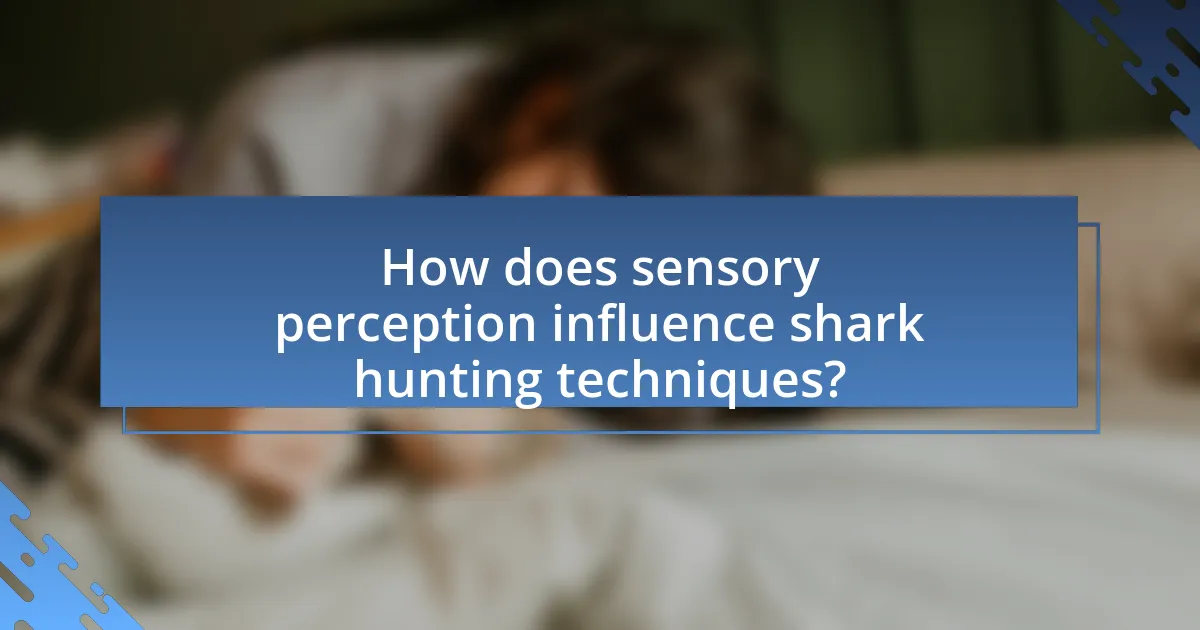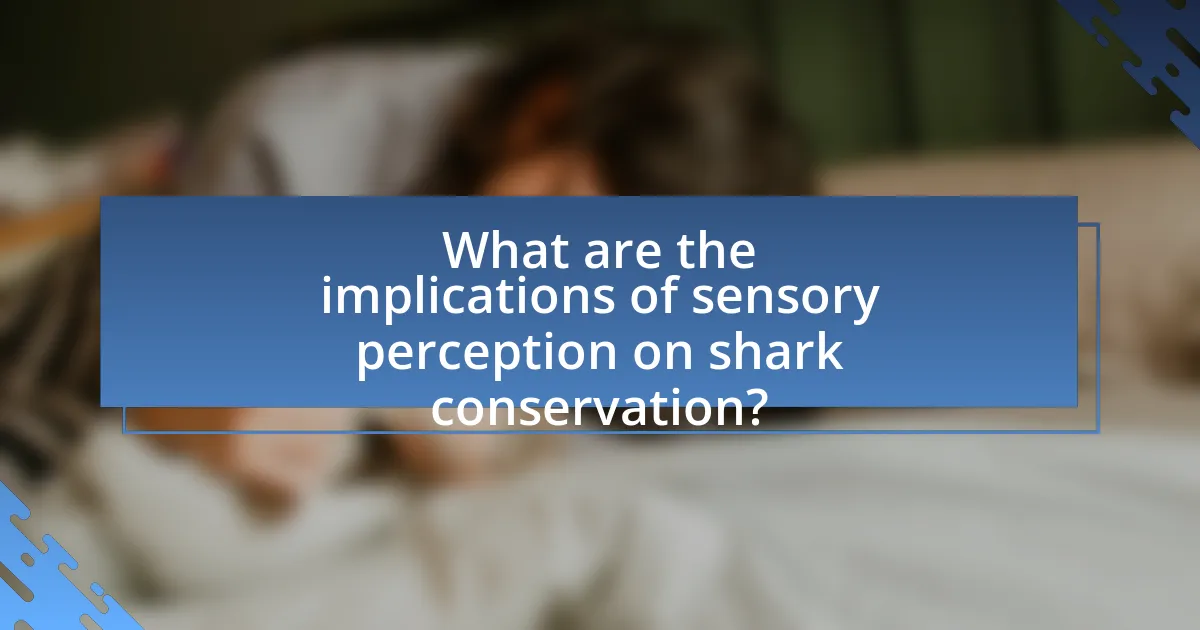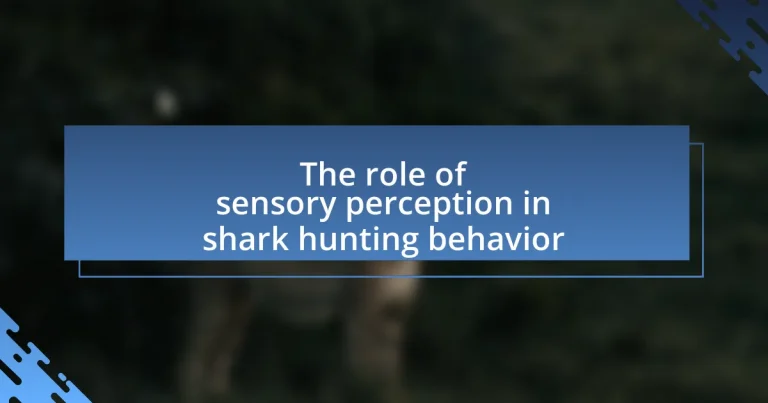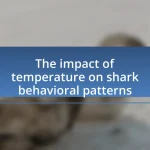The article focuses on the role of sensory perception in shark hunting behavior, highlighting how sharks utilize their advanced sensory modalities, including olfaction, electroreception, and vision, to effectively locate and capture prey. It discusses the significance of each sense in enhancing hunting success, particularly in various environmental conditions, and examines the evolutionary advantages provided by these adaptations. Additionally, the article addresses the implications of sensory perception for shark conservation, emphasizing the need for strategies that protect their habitats and inform sustainable fishing practices to ensure the survival of shark populations.

What is the role of sensory perception in shark hunting behavior?
Sensory perception plays a crucial role in shark hunting behavior by enabling sharks to detect prey through various sensory modalities. Sharks possess highly developed senses, including olfaction, electroreception, and vision, which allow them to locate and capture prey effectively. For instance, sharks can detect blood in the water from miles away due to their acute sense of smell, which is capable of identifying minute concentrations of substances. Additionally, their electroreceptors, known as ampullae of Lorenzini, allow them to sense the electric fields generated by the movements of prey, enhancing their ability to hunt in murky waters. Studies have shown that these sensory adaptations significantly increase hunting success rates, demonstrating the integral role of sensory perception in the predatory strategies of sharks.
How do sharks utilize their sensory perception during hunting?
Sharks utilize their sensory perception during hunting primarily through their acute sense of smell, electroreception, and vision. Their olfactory system can detect blood in the water from miles away, allowing them to locate prey effectively. Additionally, sharks possess specialized organs called ampullae of Lorenzini, which enable them to sense the electric fields generated by the movements of other animals, further enhancing their ability to track down prey. Their vision is adapted for low-light conditions, allowing them to see well in murky waters. These combined sensory capabilities make sharks highly efficient hunters, as evidenced by studies showing that they can detect prey even in challenging environments.
What are the primary senses involved in shark hunting?
The primary senses involved in shark hunting are olfaction, electroreception, and vision. Sharks possess an exceptional sense of smell, allowing them to detect blood and other chemicals in the water from great distances, often up to a mile away. Electroreception is facilitated by specialized organs called ampullae of Lorenzini, which enable sharks to sense the electric fields generated by the movements of prey. Additionally, sharks have keen eyesight, particularly in low-light conditions, which aids them in identifying and tracking their targets. These sensory adaptations collectively enhance a shark’s ability to locate and capture prey effectively.
How does each sense contribute to hunting success?
Sharks utilize their senses—sight, smell, hearing, and electroreception—to enhance hunting success. Vision allows sharks to detect movement and shapes in the water, aiding in identifying prey. Smell is particularly crucial, as sharks can detect blood and other scents from miles away, guiding them to potential meals. Hearing enables sharks to pick up low-frequency sounds made by struggling prey, which can indicate an easy target. Electroreception, through specialized organs called ampullae of Lorenzini, allows sharks to sense the electric fields generated by the movements of prey, even when they are hidden. Each of these senses plays a vital role in increasing the efficiency and effectiveness of sharks during hunting.
Why is sensory perception critical for sharks in their hunting strategies?
Sensory perception is critical for sharks in their hunting strategies because it enables them to detect prey effectively in their aquatic environment. Sharks possess highly developed senses, including acute olfactory capabilities that allow them to smell blood from miles away, and specialized electroreceptors called ampullae of Lorenzini that detect the electric fields generated by living organisms. These sensory adaptations enhance their ability to locate and capture prey, making them efficient hunters. For instance, studies have shown that sharks can detect minute concentrations of blood in water, which significantly increases their chances of finding injured or vulnerable prey.
How does sensory perception affect prey detection?
Sensory perception significantly enhances prey detection in sharks by allowing them to utilize multiple sensory modalities, including vision, smell, and electroreception. Sharks possess highly developed olfactory systems that can detect blood and other chemical cues in the water from great distances, enabling them to locate prey effectively. Additionally, their acute vision, particularly in low-light conditions, aids in identifying potential targets. Furthermore, sharks utilize electroreceptors known as ampullae of Lorenzini to sense the electric fields generated by the movements of prey, providing an additional layer of detection capability. This multi-faceted sensory approach increases the likelihood of successful hunting, as evidenced by studies showing that sharks can detect prey even in murky waters where visibility is limited.
What role does sensory perception play in the hunting environment?
Sensory perception is crucial in the hunting environment as it enables sharks to detect prey and navigate their surroundings effectively. Sharks utilize various sensory modalities, including olfaction, electroreception, and vision, to locate and capture prey. For instance, sharks can detect blood in the water from miles away due to their highly developed sense of smell, which is essential for identifying potential food sources. Additionally, the ampullae of Lorenzini allow sharks to sense electrical fields generated by prey, enhancing their ability to hunt in murky waters. Studies have shown that these sensory adaptations significantly increase hunting success rates, demonstrating the vital role of sensory perception in shark hunting behavior.
What adaptations have sharks developed for enhanced sensory perception?
Sharks have developed several adaptations for enhanced sensory perception, including highly sensitive electroreceptors known as ampullae of Lorenzini, acute olfactory capabilities, and excellent vision in low light conditions. The ampullae of Lorenzini allow sharks to detect electric fields generated by prey, enabling them to locate animals buried in sand or hidden in murky waters. Their olfactory system is capable of detecting blood and other chemical cues in concentrations as low as one part per billion, which is crucial for locating prey from great distances. Additionally, sharks possess a tapetum lucidum, a reflective layer behind the retina that enhances their vision in dim light, making them effective hunters during dawn and dusk. These adaptations collectively enhance their ability to sense and track prey, significantly contributing to their hunting success.
How do these adaptations improve hunting efficiency?
Shark adaptations, such as enhanced sensory perception, significantly improve hunting efficiency by allowing them to detect prey more accurately and from greater distances. For instance, the ampullae of Lorenzini enable sharks to sense electrical fields generated by the movements of prey, facilitating precise targeting even in murky waters. Additionally, their acute sense of smell can detect blood in concentrations as low as one part per million, allowing sharks to locate injured or distressed prey quickly. These adaptations collectively enhance their ability to hunt effectively, ensuring higher success rates in capturing food.
What evolutionary advantages do these adaptations provide?
Shark adaptations in sensory perception provide significant evolutionary advantages by enhancing their hunting efficiency and survival. These adaptations, such as acute olfactory capabilities, electroreception, and advanced vision, allow sharks to detect prey from great distances, navigate through various environments, and respond to stimuli effectively. For instance, sharks can sense blood in water at concentrations as low as one part per billion, which enables them to locate injured or vulnerable prey quickly. Additionally, the ability to detect electrical fields generated by other organisms through specialized organs called ampullae of Lorenzini further aids in locating prey hidden in sand or murky waters. These sensory adaptations collectively increase the likelihood of successful hunts, thereby improving the sharks’ chances of survival and reproduction in their ecological niches.

How does sensory perception influence shark hunting techniques?
Sensory perception significantly influences shark hunting techniques by enabling sharks to detect prey through various sensory modalities. Sharks possess acute senses, including the ability to detect electrical fields through electroreceptors called ampullae of Lorenzini, which allows them to locate prey even when hidden. Additionally, their keen sense of smell can detect blood in water from miles away, guiding them to injured or distressed animals. Research indicates that sharks can also use their lateral line system to sense vibrations and movements in the water, further enhancing their hunting efficiency. These sensory adaptations collectively enable sharks to execute precise hunting strategies, making them effective predators in their marine environments.
What specific hunting techniques rely on sensory perception?
Sharks utilize several specific hunting techniques that rely on sensory perception, including electroreception, vision, and olfaction. Electroreception allows sharks to detect the electric fields generated by prey, which is crucial for locating hidden or camouflaged animals. Vision plays a significant role, especially in clear waters, where sharks can spot movement and shapes from a distance. Olfaction, or the sense of smell, is highly developed in sharks, enabling them to detect blood and other chemical cues from prey over long distances, often up to several kilometers. These sensory modalities work together to enhance the hunting efficiency of sharks, allowing them to adapt to various environments and prey types.
How do sharks use electroreception in hunting?
Sharks use electroreception to detect the electric fields generated by the movements of prey, which aids in their hunting. This ability is facilitated by specialized organs called ampullae of Lorenzini, located in their snouts. These organs can sense minute electrical signals, allowing sharks to locate prey even when it is hidden beneath sand or in murky water. Research indicates that sharks can detect electric fields as weak as 1 microvolt per centimeter, demonstrating the precision of their electroreceptive capabilities. This sensory perception plays a crucial role in their hunting strategy, enabling them to effectively track and capture prey.
What is the significance of olfactory cues in hunting behavior?
Olfactory cues are crucial in hunting behavior as they enable sharks to detect prey from significant distances. Sharks possess an acute sense of smell, allowing them to identify blood and other chemical signals in the water, which can be detected up to several kilometers away. This ability enhances their hunting efficiency by guiding them toward potential food sources, thereby increasing their chances of successful predation. Research indicates that sharks can detect as little as one part per billion of certain amino acids, underscoring the importance of olfactory cues in their foraging strategies.
How do environmental factors affect sensory perception in sharks?
Environmental factors significantly influence sensory perception in sharks by altering their ability to detect prey and navigate their surroundings. For instance, changes in water temperature can affect the sensitivity of a shark’s electroreceptors, known as the ampullae of Lorenzini, which are crucial for detecting the electric fields generated by prey. Additionally, variations in salinity and turbidity can impact the transmission of sound and chemical signals in the water, thereby affecting a shark’s olfactory and auditory senses. Research indicates that sharks are more adept at hunting in clear waters where visual cues are enhanced, while murky conditions can hinder their ability to locate prey effectively. These adaptations demonstrate how environmental conditions directly shape the sensory capabilities that sharks rely on for successful hunting.
What impact does water clarity have on hunting success?
Water clarity significantly impacts hunting success for sharks. Clear water enhances a shark’s ability to detect prey through visual cues, which is crucial for their hunting strategy. Research indicates that sharks rely on sight, particularly in clear conditions, to identify and track their prey effectively. In contrast, murky water can hinder their visual perception, leading to decreased hunting efficiency. Studies have shown that sharks are more successful in capturing prey in clear water environments, as they can better utilize their acute vision to locate and ambush targets.
How do temperature and salinity influence sensory perception?
Temperature and salinity significantly influence sensory perception in sharks by affecting their ability to detect environmental cues. Sharks rely on their sensory systems, particularly the ampullae of Lorenzini, to sense electrical fields and temperature gradients in the water. Research indicates that warmer temperatures can enhance the metabolic rates of sharks, leading to increased sensory responsiveness. For instance, a study published in the Journal of Experimental Marine Biology and Ecology found that higher temperatures improved the detection of prey by sharks, as their sensory receptors became more active. Conversely, salinity levels can alter the conductivity of water, impacting the efficacy of electroreception. A study by Kajiura and Holland in the journal Marine Biology demonstrated that changes in salinity can affect the sensitivity of sharks to electrical signals, which are crucial for locating prey. Thus, both temperature and salinity play critical roles in shaping the sensory perception of sharks, directly influencing their hunting behavior.

What are the implications of sensory perception on shark conservation?
Sensory perception significantly impacts shark conservation by influencing their hunting behavior and ecological roles. Sharks rely on acute sensory systems, including electroreception and olfaction, to detect prey and navigate their environments. This reliance on sensory perception means that changes in their habitats, such as pollution or noise, can disrupt their ability to hunt effectively, leading to declines in shark populations. For instance, studies have shown that increased underwater noise can impair sharks’ ability to locate prey, which can result in decreased feeding success and ultimately affect their survival rates. Therefore, understanding sensory perception is crucial for developing effective conservation strategies that protect sharks and their ecosystems.
How does understanding sensory perception aid in shark conservation efforts?
Understanding sensory perception aids in shark conservation efforts by informing strategies that protect their habitats and reduce human-shark interactions. Sharks rely on acute sensory systems, including electroreception and olfaction, to hunt and navigate their environments. By studying these sensory mechanisms, conservationists can identify critical habitats that support shark populations and implement protective measures, such as marine protected areas. For instance, research has shown that sharks can detect prey from significant distances using their sense of smell, which emphasizes the importance of maintaining water quality and prey availability in their ecosystems. Additionally, understanding how sharks perceive their environment can help develop effective deterrents to minimize bycatch and accidental catches in fishing gear, ultimately contributing to healthier shark populations and marine ecosystems.
What strategies can be implemented to protect sharks based on their sensory needs?
To protect sharks based on their sensory needs, strategies should include the establishment of marine protected areas (MPAs) that preserve critical habitats, as well as the implementation of regulations to minimize noise pollution and chemical runoff. Marine protected areas provide safe environments where sharks can thrive, as they rely heavily on their sensory perception for hunting and navigation. Research indicates that sharks use electroreception to detect prey, and preserving their habitats ensures they have access to the resources they need. Additionally, reducing noise pollution helps maintain their ability to communicate and hunt effectively, as excessive noise can disrupt their sensory functions. Studies have shown that chemical runoff can impair their olfactory senses, making it harder for them to locate food. Therefore, these strategies directly address the sensory needs of sharks, enhancing their survival and ecological role.
How can sensory perception knowledge inform sustainable fishing practices?
Sensory perception knowledge can inform sustainable fishing practices by enhancing understanding of shark behavior and their ecological roles. By studying how sharks utilize their sensory systems—such as electroreception and olfaction—fishermen can develop targeted fishing methods that minimize bycatch and reduce the impact on shark populations. For instance, research indicates that sharks are attracted to specific scents, which can be used to create bait that selectively targets certain species while avoiding others, thereby promoting sustainable practices. Additionally, understanding the sensory cues that sharks respond to can help in designing fishing gear that is less harmful to non-target species, ultimately supporting the conservation of marine ecosystems.
What practical steps can be taken to enhance shark conservation?
To enhance shark conservation, implementing marine protected areas (MPAs) is essential, as they provide safe habitats for sharks and allow populations to recover. Research indicates that MPAs can lead to a significant increase in shark abundance; for example, a study published in the journal “Conservation Biology” found that shark populations in protected areas can increase by up to 50% within five years. Additionally, enforcing sustainable fishing practices, such as catch limits and gear restrictions, helps reduce bycatch and overfishing, which are critical threats to shark populations. The Food and Agriculture Organization (FAO) reports that overfishing has led to a decline in shark populations by as much as 90% in some regions. Public awareness campaigns can also play a vital role in changing perceptions about sharks, promoting their ecological importance and reducing fear-based attitudes. These combined efforts can significantly contribute to the conservation of shark species and their habitats.


